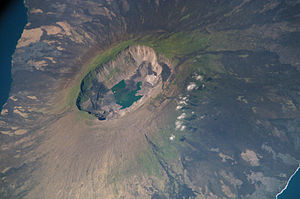geo.wikisort.org - Island
Fernandina Island (Spanish: Isla Fernandina, named after King Ferdinand of Spain, the sponsor of Christopher Columbus) (formerly known in English as Narborough Island, after John Narborough) is the third largest, and youngest, island of the Galápagos Islands, as well as the furthest west.[2] Like the others, the island was formed by the Galápagos hotspot. The island is an active shield volcano that has most recently been erupting since April 11, 2009.[3]
 Fernandina Island | |
| Geography | |
|---|---|
| Location | Galápagos Islands, Ecuador |
| Coordinates | 0°22′S 91°33′W |
| Archipelago | Galápagos Islands |
| Area | 642 km2 (248 sq mi) |
| Highest elevation | 1,476 m (4843 ft) |
| Highest point | Volcan La Cumbre |
| Administration | |
Ecuador | |
| Province | Galápagos |
| Fernandina | |
|---|---|
 Fernandina Island (centre) and Isabela Island | |
| Highest point | |
| Peak | Volcan La Cumbre |
| Elevation | 1,476 m (4,843 ft) |
| Coordinates | 0°22′S 91°33′W |
| Geography | |
 Fernandina Galápagos Islands, Ecuador | |
| Geology | |
| Mountain type | Shield volcano |
| Last eruption | 2020[1] |
On February 14, 1825, while anchored in Banks Bay, Captain Benjamin Morrell recorded one of the largest eruptions in Galápagos' history at Fernandina Volcano. His ship escaped to safety and his account of the event was preserved.[4]
Fernandina has an area of 642 km2 (248 sq mi) and a height of 1,476 m (4,843 ft), with a summit caldera about 6.5 km (4.0 mi) wide. The caldera underwent a collapse in 1968, when parts of the caldera floor dropped 350 m (1,150 ft). A small lake has intermittently occupied the northern caldera floor, most recently in 1988.
Due to its recent volcanic activity, the island does not present much plant life and has a mostly rocky surface. Visitors to Fernandina Island will be taken to see only the outskirts of the crater for safety reasons. Two types of lava flow can be observed, ʻaʻā and pāhoehoe.
Flora and fauna
Punta Espinoza is a narrow stretch of land where hundreds of marine iguanas gather in large groups on black lava rocks. The famous flightless cormorant inhabits this island as well as penguins, pelicans and sea lions. The Narborough Island tortoise is a highly elusive species of Galápagos tortoise restricted to the island, thought likely extinct when no sighting had been made for 113 years after 1906, one old female being found in 2019.[5]
Mangrove forests are also found on the island.
April 2009 Eruption
The southern flank of the volcano La Cumbre had a fissure eruption that generated flows, which subsided within hours. Isla Fernandina supports wildlife that was threatened by the April 2009 burst of volcanic activity, according to rangers at Galápagos National Park. As the island has no human residents, no settlements were endangered. Park rangers and a passing tourist boat initially observed the volcano at 10:00 p.m. local time on April 10, 2009. A sparse human population in the western reaches of the Galápagos Islands means that volcanic activity is not always observed or reported as soon as it starts. The seismic station at Puerto Ayora, on the nearby island of Santa Cruz, recorded no earthquakes associated with this eruption.


See also
References
- "Fernandina". Global Volcanism Program. Smithsonian Institution. Retrieved 2021-02-05.
- "Fernandina". Galapagos Conservancy. galapagos.org. Retrieved 6 June 2017.
- "Galapagos volcano erupts, could threaten wildlife". 2009-04-15. Archived from the original on 2009-04-15. Retrieved 2016-11-11.
{{cite web}}: CS1 maint: bot: original URL status unknown (link) - Kricher, John C. (2006). Galapagos: A natural history. Princeton: Princeton University Press. p. 57. ISBN 978-0-691-12633-3. Retrieved February 12, 2009.
- "Giant tortoise believed extinct for 100 years found in Galápagos". The Guardian. 21 February 2019. Retrieved 21 February 2019.
External links
- Special Report: Volcano Erupts on Fernandina Island. Charles Darwin Foundation
- Fernandina
- Benjamin Morell and the Galápagos Eruption of 1825 Archived 2017-07-07 at the Wayback Machine
- Eruption on Isla Fernandina NASA Earth Observatory
На других языках
[de] Fernandina
Fernandina (englisch Narborough Island) ist die drittgrößte der Galapagosinseln. Die Insel trägt ihren Namen zu Ehren von König Ferdinand II. von Aragonien, der die erste Reise des Christoph Kolumbus unterstützt hatte.- [en] Fernandina Island
[es] Isla Fernandina
Fernandina[1] es una isla perteneciente al Ecuador, ubicada en las islas Galápagos, en el océano Pacífico. Es la tercera más grande del archipiélago tras Isabela y Santa Cruz. Uno de los volcanes más activos del mundo se encuentra en esta isla.[fr] Île Fernandina
L'île Fernandina, en espagnol Isla Fernandina, aussi appelée île Narborough, est une île inhabitée d'Équateur située dans l'archipel des Galápagos.[ru] Фернандина
Фернанди́на (Нарборо)[1] (исп. Fernandina, Narborough) — третий по размеру и самый молодой в геологическом отношении остров островов Галапагос.Другой контент может иметь иную лицензию. Перед использованием материалов сайта WikiSort.org внимательно изучите правила лицензирования конкретных элементов наполнения сайта.
WikiSort.org - проект по пересортировке и дополнению контента Википедии